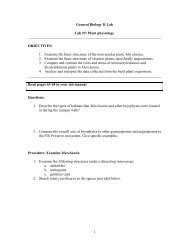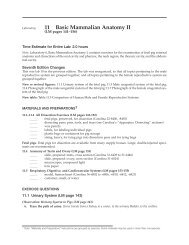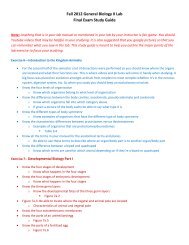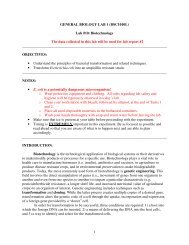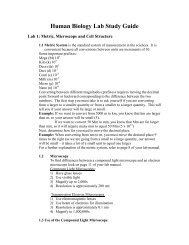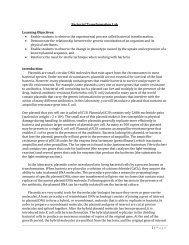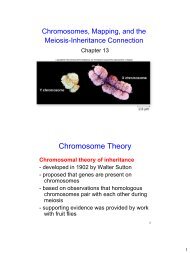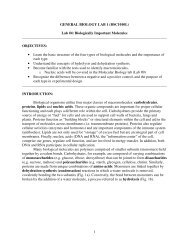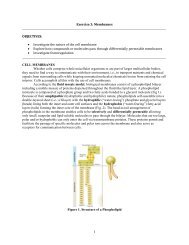Lab #7: Introduction to the Kingdom Animalia Objectives: 1 ...
Lab #7: Introduction to the Kingdom Animalia Objectives: 1 ...
Lab #7: Introduction to the Kingdom Animalia Objectives: 1 ...
Create successful ePaper yourself
Turn your PDF publications into a flip-book with our unique Google optimized e-Paper software.
Pro<strong>to</strong>s<strong>to</strong>mes<br />
(mouth first)<br />
Deuteros<strong>to</strong>mes<br />
(mouth second)<br />
Cleavage type Spiral Radial<br />
Blas<strong>to</strong>pore<br />
Mouth<br />
Anus<br />
becomes<br />
Representative<br />
Phyla<br />
Platyhelmin<strong>the</strong>s, Arthropoda,<br />
Annelida, Mollusca, Nema<strong>to</strong>da, and<br />
smaller phyla<br />
Chordata, Echinodermata, and<br />
smaller phyla<br />
Example species Nema<strong>to</strong>da - Ascaris Sea star – Asterias<br />
Drawing<br />
Task 5: Describing positions in bilaterally symmetrical animals<br />
For a large portion of this course we will be examining bilaterally symmetrical animals from<br />
various phyla. To be able <strong>to</strong> locate and refer <strong>to</strong> specific regions of animal bodies, we will use<br />
terminology in your lab manual (pg. 523).<br />
Practice with your group using directional terms <strong>to</strong> refer <strong>to</strong> a particular part/portion of <strong>the</strong> body.<br />
You may use available specimens <strong>to</strong> practice. Make sure <strong>to</strong> use both radially and bilaterally<br />
symmetrical animals.<br />
The table below compares <strong>the</strong> terms used <strong>to</strong> describe animals with bilateral and radial<br />
symmetries.



